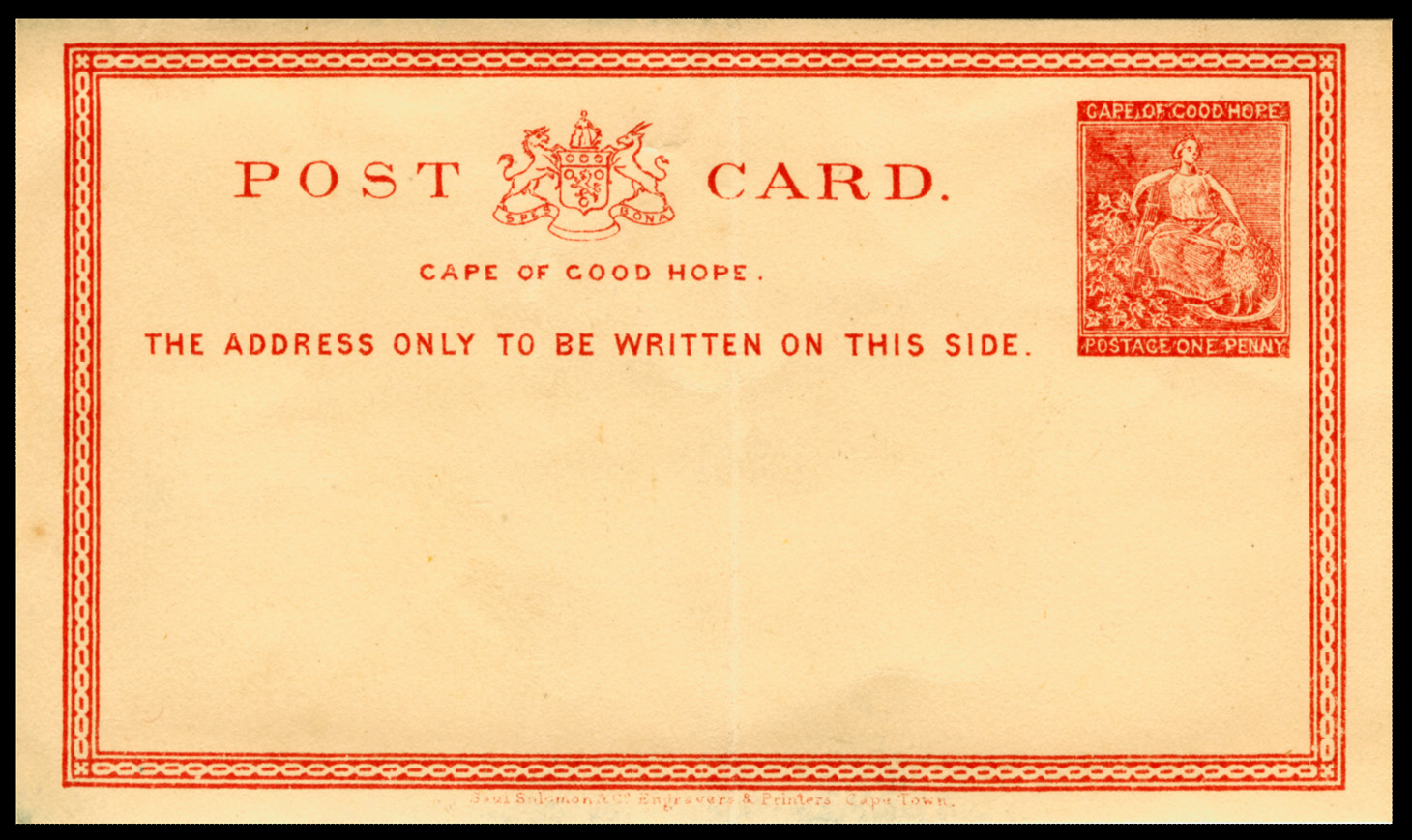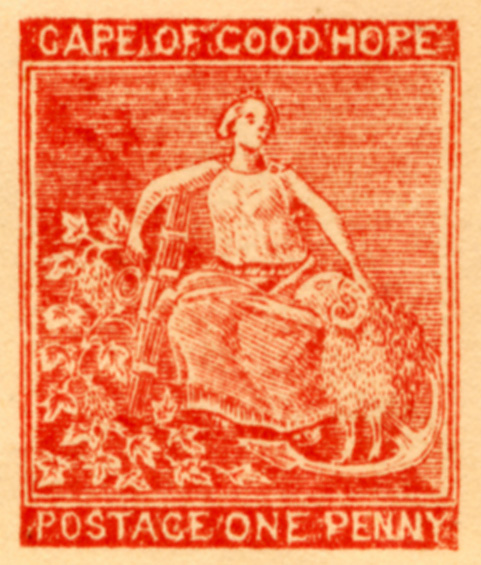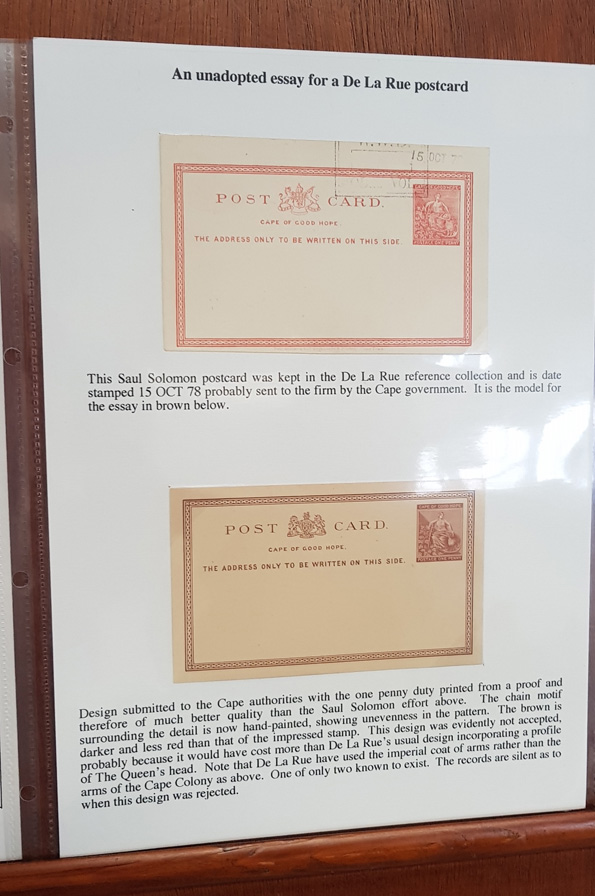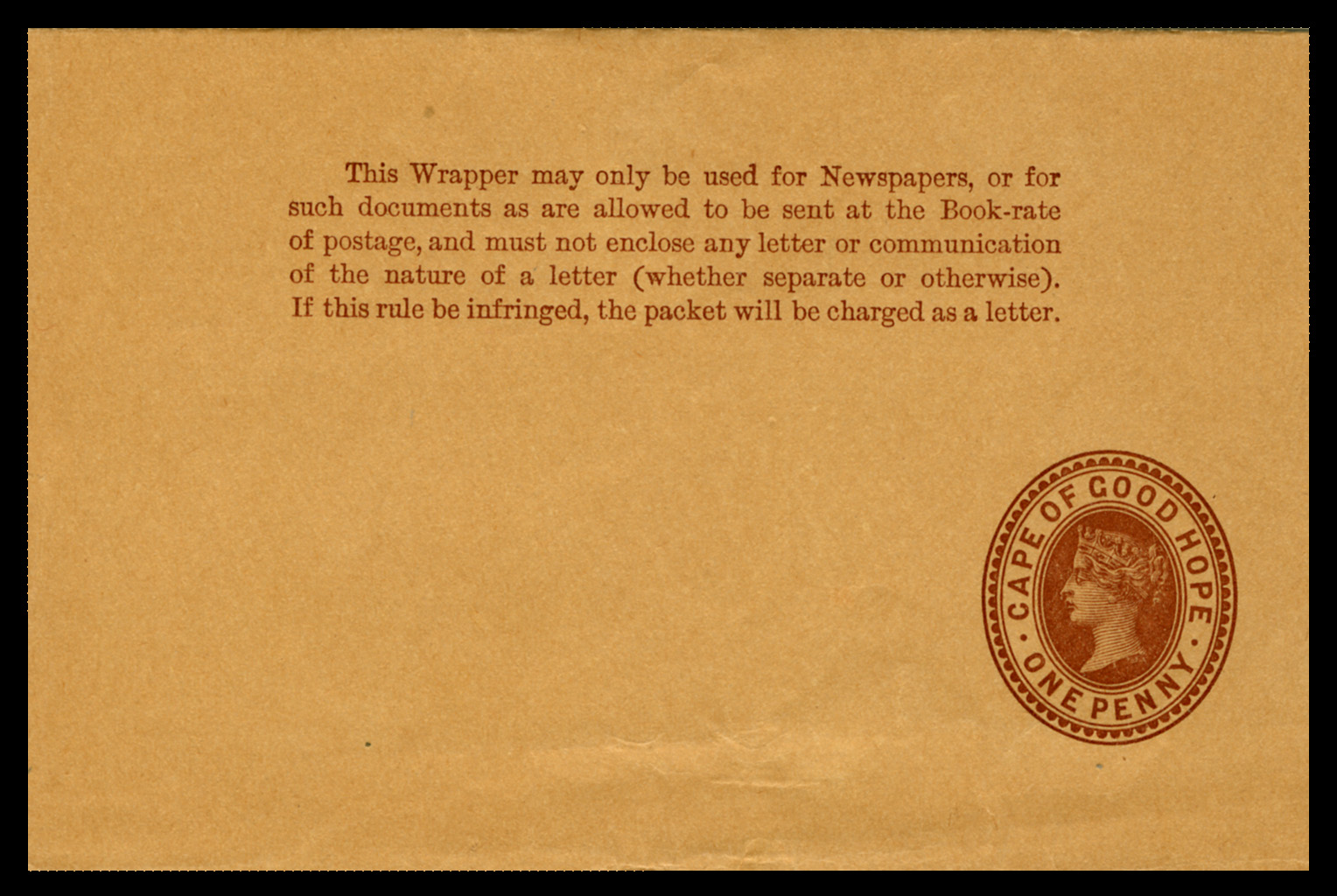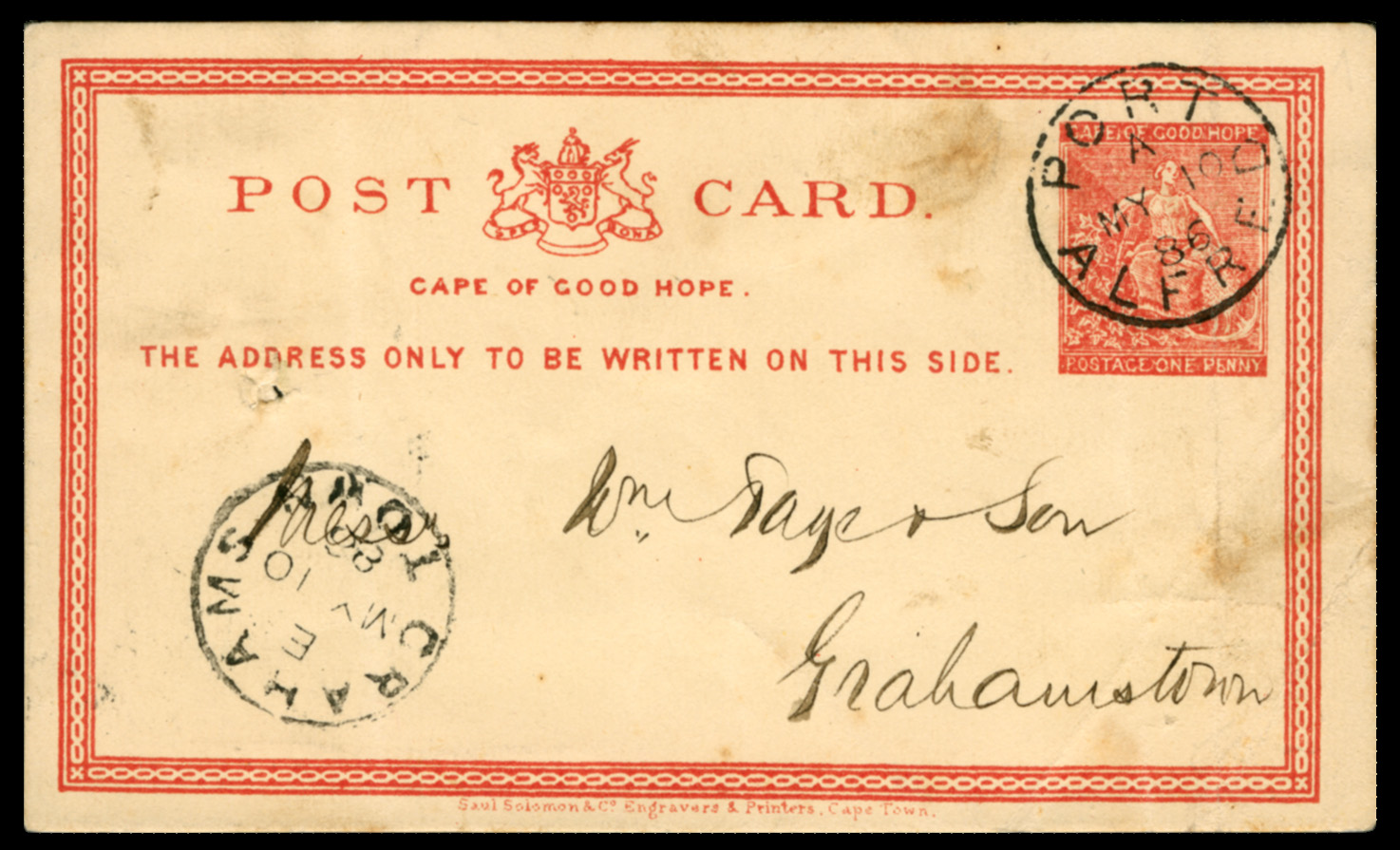The Locally Designed Cape Postcard of 1878.
Quote from Steve on April 11, 2023, 12:02 pmPostal Stationery Post Cards of the Cape Colony
I do not usually buy postal stationery but a week before the 8th April SACS meeting in Letchworth I bought a mint Cape postcard, below, which I found among Charlie Rudge's material at the Knebworth Stamp Fair. . I had never seen one before. A week later, I had the great good fortune to hear a short display by senior philatelic researcher Dr Chris Board RDPSA on the subject of my postcard. In one week I went from total ignorance to having an expert tell me pretty much all that is known about it. Synchronicity had struck again!
These 1d postcards were locally designed and produced by Saul Solomon in Cape Town in 1878. The example I bought and show below was issued by the Cape Post Office in March 1878. Its most notable feature is a 'chain' border, the arms of the colony and the poorly printed image of the then current 1d postage adhesive stamp produced by De La Rue. The crudeness of the 1d duty 'stamp' suggests it was redrawn. Compared to the rectangular adhesive stamps, the postcard's representation of Hope looks more like a forgery. She is wide-eyed with the appearance of a dementia'ed stuffed straw doll. There is nothing imperious and commanding about this colonial bumpkin.
According to Chris, the post cards were lithographed in Cape Town with 50,000 being printed. There was probably an expectation that they would be used in the domestic 'Penny Post' system flourishing around Cape Town. However, they proved to be unpopular with the public for a variety of reasons, perhaps the main one being that they were thought to be too thin for the rough and tumble of the post bag. To make quality control matters worse, they were also badly guillotined. My example, however, seems pretty uniform but the example Chris showed was defintely trimmed too close to the border. And then, of course, there's the uninspiring, dorkish-looking Hope.
Here are some facts as determined by Chris:
1]. that the Cape Treasurer had advised the Postmaster General that De La Rue would charge more to prepare and print 1d postcards than any likely revenue were to be derived from their use in 1877-78,
2]. that 50,000 cards were printed by Saul Solomon the Government Printer, who was paid by government draft £25.5s on 10 October 1878,
3]. that copies had reached the local philatelic press in 1878,
4]. that only £9 worth, or 2,160, cards at face value had been issued in 1878,
5]. that none of these cards had been issued in the years 1879-81,
6]. that 41, 376 of these cards had been issued from stock by the end of April 1882,
7]. that the Cape government under contract to De La Rue did order a postcard from them in 1881. The duty (represenation of the Queen with value) had already been used for a newspaper wrapper,
8]. that essays of these cards have never been found. (Chris' "The Mystery of the De La Rue Essay of 1878".)
An Unadopted Essay for a De La Rue Postcard
According to Chris, De La Rue in Britain were sent a Saul Solomon postcard, probably by the Cape Government, which the company kept in its reference collection. It is stamped and dated '15 OCT 78'. It became the model for a De La Rue essay in brown.
"De La Rue's design was submitted to the Cape authorities with the one penny duty printed from a proof and therefore of much better quality than the Saul Solomon effort," says Chris. "The chain motif (border) surrounding the detail is now hand-painted, showing unevenness in the pattern. The brown is darker and less red than that of the impressed stamp. This design was evidently not accepted, probably because it would have cost more than De La Rue's usual design incorporating a profile of The Queen's Head. Note that De La Rue have used the Imperial coat of arms rather than the arms of the Cape Colony." Chris's example is one of only two known to exist. "The records", he says, "are silent as to when this design was rejected."
"Examples of Black postal cards were noted by Bacon, who regarded them as proofs which got mixed up with the issued cards in their striking vermillion colour. Black ones were sold at the auction of the Wilhelm Grutter collection in Johannesburg in February 2002 where it was described as an essay and one of only two known," said Chris.
Images
1]. Cape Postcard of 1878 ex. Saul Solomon purchased in Knebworth.
2]. Enlargement of the Solomon reproduction of the 1d adhesive duty.
3]. A sheet from Chris's display showing the De La Rue Essay.
4]. Newspaper wrapper possibly showing De La Rue duty used on 18881 postcard.
Postal Stationery Post Cards of the Cape Colony
I do not usually buy postal stationery but a week before the 8th April SACS meeting in Letchworth I bought a mint Cape postcard, below, which I found among Charlie Rudge's material at the Knebworth Stamp Fair. . I had never seen one before. A week later, I had the great good fortune to hear a short display by senior philatelic researcher Dr Chris Board RDPSA on the subject of my postcard. In one week I went from total ignorance to having an expert tell me pretty much all that is known about it. Synchronicity had struck again!
These 1d postcards were locally designed and produced by Saul Solomon in Cape Town in 1878. The example I bought and show below was issued by the Cape Post Office in March 1878. Its most notable feature is a 'chain' border, the arms of the colony and the poorly printed image of the then current 1d postage adhesive stamp produced by De La Rue. The crudeness of the 1d duty 'stamp' suggests it was redrawn. Compared to the rectangular adhesive stamps, the postcard's representation of Hope looks more like a forgery. She is wide-eyed with the appearance of a dementia'ed stuffed straw doll. There is nothing imperious and commanding about this colonial bumpkin.
According to Chris, the post cards were lithographed in Cape Town with 50,000 being printed. There was probably an expectation that they would be used in the domestic 'Penny Post' system flourishing around Cape Town. However, they proved to be unpopular with the public for a variety of reasons, perhaps the main one being that they were thought to be too thin for the rough and tumble of the post bag. To make quality control matters worse, they were also badly guillotined. My example, however, seems pretty uniform but the example Chris showed was defintely trimmed too close to the border. And then, of course, there's the uninspiring, dorkish-looking Hope.
Here are some facts as determined by Chris:
1]. that the Cape Treasurer had advised the Postmaster General that De La Rue would charge more to prepare and print 1d postcards than any likely revenue were to be derived from their use in 1877-78,
2]. that 50,000 cards were printed by Saul Solomon the Government Printer, who was paid by government draft £25.5s on 10 October 1878,
3]. that copies had reached the local philatelic press in 1878,
4]. that only £9 worth, or 2,160, cards at face value had been issued in 1878,
5]. that none of these cards had been issued in the years 1879-81,
6]. that 41, 376 of these cards had been issued from stock by the end of April 1882,
7]. that the Cape government under contract to De La Rue did order a postcard from them in 1881. The duty (represenation of the Queen with value) had already been used for a newspaper wrapper,
8]. that essays of these cards have never been found. (Chris' "The Mystery of the De La Rue Essay of 1878".)
An Unadopted Essay for a De La Rue Postcard
According to Chris, De La Rue in Britain were sent a Saul Solomon postcard, probably by the Cape Government, which the company kept in its reference collection. It is stamped and dated '15 OCT 78'. It became the model for a De La Rue essay in brown.
"De La Rue's design was submitted to the Cape authorities with the one penny duty printed from a proof and therefore of much better quality than the Saul Solomon effort," says Chris. "The chain motif (border) surrounding the detail is now hand-painted, showing unevenness in the pattern. The brown is darker and less red than that of the impressed stamp. This design was evidently not accepted, probably because it would have cost more than De La Rue's usual design incorporating a profile of The Queen's Head. Note that De La Rue have used the Imperial coat of arms rather than the arms of the Cape Colony." Chris's example is one of only two known to exist. "The records", he says, "are silent as to when this design was rejected."
"Examples of Black postal cards were noted by Bacon, who regarded them as proofs which got mixed up with the issued cards in their striking vermillion colour. Black ones were sold at the auction of the Wilhelm Grutter collection in Johannesburg in February 2002 where it was described as an essay and one of only two known," said Chris.
Images
1]. Cape Postcard of 1878 ex. Saul Solomon purchased in Knebworth.
2]. Enlargement of the Solomon reproduction of the 1d adhesive duty.
3]. A sheet from Chris's display showing the De La Rue Essay.
4]. Newspaper wrapper possibly showing De La Rue duty used on 18881 postcard.
Uploaded files:
Quote from Steve on March 15, 2024, 5:11 pmI have now managed to find a used example. These are uncommon, perhaps due to their unpopularity with the public. Bob Hill has a newspaper cutting from the time that said that the Post Office should fellow the example of those who sold penguin eggs on the streets of Cape Town and sell them at six per a penny - or words to that effect. The card is thin which probably contributed to their unpopularity.
The card travelled from Port Alfred to Grahamstown on 'MY 10 86', a same day service. Both strikes are with the single circle datestamp. The time code for Port Alfred was 'A' and for Grahamstown it was 'E'. It left early and arrived late-ish.
I have now managed to find a used example. These are uncommon, perhaps due to their unpopularity with the public. Bob Hill has a newspaper cutting from the time that said that the Post Office should fellow the example of those who sold penguin eggs on the streets of Cape Town and sell them at six per a penny - or words to that effect. The card is thin which probably contributed to their unpopularity.
The card travelled from Port Alfred to Grahamstown on 'MY 10 86', a same day service. Both strikes are with the single circle datestamp. The time code for Port Alfred was 'A' and for Grahamstown it was 'E'. It left early and arrived late-ish.
Uploaded files:
